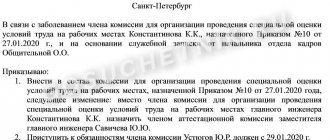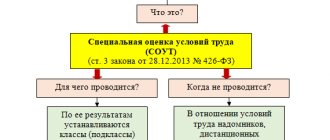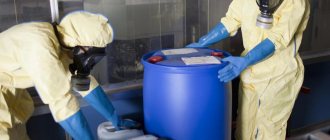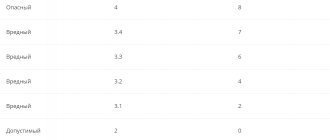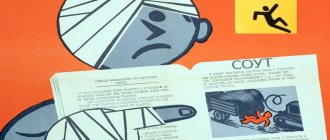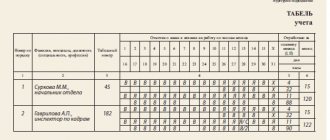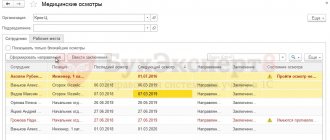Modern industry is actively developing, involving ever newer and more advanced technologies. At the same time, in order for a person to achieve a comfortable level of everyday life, certain categories of employed people are forced to risk their health by devoting themselves to dangerous production. Company management highly values the contribution to the development of the business and the courage of such employees, therefore they carefully monitor the provision of privileges for different subclasses, however, before assigning bonuses to employees, it is necessary first of all to study the boundaries of acceptable and harmful working conditions in workplaces that are assigned the 2nd (second ) class: what it means, for whom it is established, what characterizes the degree of harmfulness and danger of work, assessment of the final and general accepted values on a special scale. Next, take a closer look at the procedure for assigning and canceling compensation surcharges and whether they are needed for this category.
Existing levels
Since the adoption of the Labor Code and at the present time, 4 categories have been distinguished. The document describes the division of professions according to the complexity or danger of existing production factors. Depending on the adopted gradation, additional payments, privileges and benefits for employees of the enterprise are also described.
These requirements and rules are prescribed in the Federal Law of the Russian Federation No. 42, on the basis of which it is possible to distinguish 4 levels of harmfulness:
- the first is characterized by optimal, in other words, normal indicators;
- the second is the permissible nature of the work;
- the third indicates the presence of harmful, severe or complex factors;
- the last, that is, the fourth, describes working conditions in which the likelihood of harm to health is high.
To determine current data, the employer carries out the SOUT procedure once every 5 years. Its implementation is mandatory for all organizations, regardless of the number of employees, but assessment for employees working remotely is completely excluded.
Assessment and assignment of a class of working conditions
Risk assessment is carried out by a special accredited company that carries out special assessment and assessment. This is a special assessment procedure, the purpose of which is to analyze the following production factors:
- degree of illumination of premises;
- percentage of harmful impurities in the air;
- coefficient display of microclimate parameters;
- level of noise, vibration, ultrasonic and infrasonic influence;
- the presence or absence of electromagnetic, radiation or ionizing radiation.
Based on the analysis, the SOUT commission assigns a hazard level corresponding to the classification to workplaces.
Ready-made solutions for all areas
Stores
Mobility, accuracy and speed of counting goods on the sales floor and in the warehouse will allow you not to lose days of sales during inventory and when receiving goods.
To learn more
Warehouses
Speed up your warehouse employees' work with mobile automation. Eliminate errors in receiving, shipping, inventory and movement of goods forever.
To learn more
Marking
Mandatory labeling of goods is an opportunity for each organization to 100% exclude the acceptance of counterfeit goods into its warehouse and track the supply chain from the manufacturer.
To learn more
E-commerce
Speed, accuracy of acceptance and shipment of goods in the warehouse is the cornerstone in the E-commerce business. Start using modern, more efficient mobile tools.
To learn more
Institutions
Increase the accuracy of accounting for the organization’s property, the level of control over the safety and movement of each item. Mobile accounting will reduce the likelihood of theft and natural losses.
To learn more
Production
Increase the efficiency of your manufacturing enterprise by introducing mobile automation for inventory accounting.
To learn more
RFID
The first ready-made solution in Russia for tracking goods using RFID tags at each stage of the supply chain.
To learn more
EGAIS
Eliminate errors in comparing and reading excise duty stamps for alcoholic beverages using mobile accounting tools.
To learn more
Certification for partners
Obtaining certified Cleverence partner status will allow your company to reach a new level of problem solving at your clients’ enterprises.
To learn more
Inventory
Use modern mobile tools to carry out product inventory. Increase the speed and accuracy of your business process.
To learn more
Mobile automation
Use modern mobile tools to account for goods and fixed assets in your enterprise. Completely abandon accounting “on paper”.
Learn more Show all automation solutions
List of professions with hazardous working conditions
There are two main approaches to identifying positions with hazardous working conditions at an enterprise:
- Reconciliation of jobs available at the enterprise with lists of those professions that are characterized by law as having harmful working conditions.
- Carrying out identification of hazardous working conditions as part of a special assessment (if work positions in the company do not correspond to the legally established lists of “harmful” professions).
The lists of professions with hazardous working conditions can be found using such a source of law as Decree of the Government of the Russian Federation dated July 16, 2014 No. 665.
The main purpose of this legal regulation is to regulate the conditions for a citizen’s early acquisition of the right to an insurance pension. But since one of these conditions may be work under hazardous working conditions, the structure of the specified legal acts contains correspondence with various sources of law, which contain lists of professions with hazardous working conditions.
For example, a wide list of professions characterized by harmful working conditions is determined by Resolution of the USSR Cabinet of Ministers dated January 26, 1991 No. 10.
The second mechanism for identifying harmful working conditions is their identification, which is implemented within the framework of a special assessment of working conditions, which is carried out in accordance with the standards:
- Law No. 426-FZ;
- Order of the Ministry of Labor of the Russian Federation dated January 24, 2014 No. 33n.
Identification is a set of measures aimed at identifying harmful production factors, as well as studying the level of intensity of their impact. If it turns out to be higher than the standards, harmful working conditions are recorded at the corresponding working position.
Note that before Law No. 426-FZ came into force, the identification procedure based on key characteristics corresponded to a set of measures within the framework of workplace certification. At the same time, such a concept as harmful working conditions was also used during certification.
The degree of harmfulness of working conditions of class 2: what does it mean?
The maximum permissible values have a very fine line. If the current situation is equal to class 2, then this means that exceeding even an insignificant amount of exposure can lead to harm to the body and health, which means that a fourth degree will be established for the profession. This feature obliges us to distinguish 4 subclasses:
- Stage 1 - when performing duties, there are risks for the employee, and the body is unable to restore resources by the beginning of the next day;
- the 2nd is characterized by the development of occupational diseases in a mild stage, which does not entail loss of working capacity;
- on the third, the illness is of moderate severity, that is, the employee will not be able to continue moving up the career ladder in the chosen direction after 15 years;
- the last (fourth) is characterized by the manifestation of occupational diseases that have serious consequences, which affect the complete loss of working capacity.
Regular carrying out of special assessment and assessment allows us to identify the most vulnerable limits for the possibility of providing compensation to employees for production costs that affect their lives.
What are hazardous working conditions?
The concept of “harmful working conditions” under consideration is closely related to the term “harmful production factors”.
In the norms of paragraph 4 of Art. 14 of the Law “On Special Assessment of Working Conditions” dated December 28, 2013 No. 426-FZ, the legislator defines as harmful working conditions in which an employee of an enterprise is exposed to harmful production factors, and the intensity of this impact is higher than the standards.
According to GOST 12.0.003-2015, such factors should include:
- By the nature of the impact on the working person’s body:
- to physical factors (for example, work in the presence of a significant amount of dust in the air, insufficient or too bright lighting, as well as noise, radiation);
- biological factors (in particular, working in conditions of high concentrations of harmful microorganisms);
- chemical factors (working with toxic substances and gases or being exposed to them).
- By source of origin:
- psychophysiological (overload associated with hard work, with the nervous tension of the labor process);
- organizational and managerial (poor organization of work, low safety culture);
- personal-behavioral (related to the personality of the employee himself);
- socio-economic (the specified GOST is not detailed, but we can talk about crises in terms of the employee’s career growth, increasing his income).
If the intensity of the impact of these factors exceeds the norms, the work position in which the corresponding factors are observed is recognized as characterized by harmful working conditions.
Medical examination for second level personnel
In the case of the 2nd degree of danger, medical examinations are not an obligation for both parties to the employment contract. The rule is described at the all-Russian government level and confirmed by the recommendations of Rospotrebnadzor. At the same time, medical examinations are recommended for representatives of categories 3 and 4, as well as for workers in the motor transport environment. Such features make it possible to timely identify access to performing assigned tasks and prevent the development of occupational diseases.
Production environment
For a comprehensive analysis, the characteristics of the following types of impact are taken into account:
- physical is assessed by illumination, the presence of constant noise or vibration, microclimate. It is also possible to detect electromagnetic or UV radiation. The source may be the equipment used, with which the employee is constantly in contact;
- chemical is characterized by the spatial determination of harmful compounds obtained by synthesis;
- biological means the presence of pathogenic and harmful microorganisms.
Labor process
For this point, experts identify the following criteria:
- the severity factor of working conditions of class 2 is physical activity;
- tension in terms of overload of the nervous system and sensory organs.
In this case, all indicators are taken into account: those that increase or decrease the level. So, for example, the need to carry cargo, the distance to the destination, weight, number of transported items, and time costs are determined.
Work is considered stressful if workers need to constantly maintain concentration, perform monotonous actions, communicate a lot, or manage transport, which is most typical for a dispatcher, driver, or assembly line worker.
Special assessment procedure
The algorithm of actions during OSHS is prescribed in the legislation. Neither employers nor experts have the right to change it. To implement measures within the framework of a special assessment of working conditions, it is necessary to involve qualified officials employed in companies from the list of specialized organizations. Part 4 of Article 10 of Federal Law No. 426-FZ provides for a simplified procedure for special assessment. This is allowed if at the initial stage it is possible to assign class 1 or class 2 working conditions - what does this mean:
- there are no harmful factors at the enterprise;
- identification of dangerous or harmful conditions for workers did not reveal any excess of standard values;
- working conditions are considered acceptable; further laboratory and expert procedures are not necessary.
If, based on the results of a special assessment, the labor safety indicator has improved, instead of class 3 or 4, the report shows class 2 working conditions, a medical examination for workers is no longer mandatory. Only those workers who are required to regularly check their health without reference to the degree of harmfulness of production factors will be required to undergo a medical examination.
When the class of working conditions is changed from harmful or dangerous to acceptable for employees, benefits are canceled, compensation payments and additional payments for unfavorable working conditions may be reduced. In such situations, employees have the right to challenge the results of the OHSMS. The regulatory documents in these cases are:
- Law No. 426-FZ (Article 26);
- Order of the Ministry of Labor dated December 5, 2016 No. 709n.
As shown in the rental agreement
The inclusion of information that the 2nd class of hazardous working conditions has been assigned and the presence of dangerous and severe criteria is mandatory. The data is placed in a special section, where additional information about the SOUT is published. If the position belongs to the second level, then it is necessary to prescribe actions to comply with requirements and standards.
How it happens
The assessment of labor activity factors is carried out:
- in a general manner according to the methodology approved in 2014 by the Russian Ministry of Labor;
- in a simplified manner.
The work of the commission generally involves:
- identifying the specifics of work in each structural unit;
- study of workers' performance indicators after rest;
- determining the degree of harm (whether work is associated with microbes, allergens, ionizing radiation, chemical reagents, etc.);
- conducting medical examinations to identify occupational diseases;
- assignment of working conditions to the appropriate class.
A simplified inspection procedure is applied if, after stages 1, 2 and 3, the commission does not identify harmful loads on the employee, and the working conditions correspond to category 1 or 2. In this case, the next stage of the study (medical examination) is not necessary.
According to the timing of the SOUT, it can be:
- planned;
- unscheduled.
Regular inspections of workplaces should be carried out once every 5 years.
The employer must carry out this earlier if the enterprise:
- new positions were introduced that were not evaluated;
- harmful products or materials have been introduced that have not been used in production before;
- diseases characteristic of each profession were identified;
- accidents or deaths occurred.
An unscheduled analysis of working conditions must be initiated no later than 6 months from the date of occurrence of at least one of these cases. If the enterprise does not conduct an inspection, a special labor inspection may be carried out at the insistence of a trade union organization or a state labor inspector.
After the inspection, the commission draws up a report.
The employer notifies the trade union organization of the results. Also, the results of the commission’s activities are brought to the attention of the Labor Inspectorate and the Social Insurance Fund. Based on this, a declaration is filled out, from which the Pension Fund calculates the amount of pension contributions.
Typical managerial mistakes that arise as a result of incorrect interpretation of the rules on conducting an analysis of working conditions are:
- recognition of a hazard class without inspection;
- ignoring the need to carry out SOUT.
For example, if the legal address changes, the enterprise must re-assess the conditions for employees to carry out work activities. In this case, the employer should not arbitrarily determine the class in the employment contract with the employee.
Sometimes they include in an employment agreement a provision stating that the work is harmful in nature without conducting an analysis of the degree of harm at all. At the same time, pension contributions for employees at additional tariffs are not made due to the fact that the official assessment has not yet been made.
If management itself decides to establish the class of working conditions for an employee, the latter should be provided with all benefits arising from this category not from the moment the appropriate assessment is carried out, but from the moment the employment contract is signed.
SOUT is one of the most important guarantees of workers’ rights to fair remuneration for hard work.
The result of the assessment will determine whether the employee will work 40 or 36 days a week, what rest period should be set between shifts, etc. Neglect can adversely affect both production efficiency and employee health.
Ready-made solutions for all areas
Stores
Mobility, accuracy and speed of counting goods on the sales floor and in the warehouse will allow you not to lose days of sales during inventory and when receiving goods.
To learn more
Warehouses
Speed up your warehouse employees' work with mobile automation. Eliminate errors in receiving, shipping, inventory and movement of goods forever.
To learn more
Marking
Mandatory labeling of goods is an opportunity for each organization to 100% exclude the acceptance of counterfeit goods into its warehouse and track the supply chain from the manufacturer.
To learn more
E-commerce
Speed, accuracy of acceptance and shipment of goods in the warehouse is the cornerstone in the E-commerce business. Start using modern, more efficient mobile tools.
To learn more
Institutions
Increase the accuracy of accounting for the organization’s property, the level of control over the safety and movement of each item. Mobile accounting will reduce the likelihood of theft and natural losses.
To learn more
Production
Increase the efficiency of your manufacturing enterprise by introducing mobile automation for inventory accounting.
To learn more
RFID
The first ready-made solution in Russia for tracking goods using RFID tags at each stage of the supply chain.
To learn more
EGAIS
Eliminate errors in comparing and reading excise duty stamps for alcoholic beverages using mobile accounting tools.
To learn more
Certification for partners
Obtaining certified Cleverence partner status will allow your company to reach a new level of problem solving at your clients’ enterprises.
To learn more
Inventory
Use modern mobile tools to carry out product inventory. Increase the speed and accuracy of your business process.
To learn more
Mobile automation
Use modern mobile tools to account for goods and fixed assets in your enterprise. Completely abandon accounting “on paper”.
Learn more Show all automation solutions
How to cancel benefits when you drop in level
Cancellation of privileges in relation to employees is carried out only after the provision of the necessary documentation about the reduction of the severity indicator to the second in connection with the normalization of characteristics for workplaces or the replacement of production equipment. For such situations, an order will be required from the organization’s management, which is approved by the chief executive, the Ministry of Labor and Rospotrebnadzor.
As the second degree is established, the commission establishes that the impact on employees of production and labor factors is minimal and fluctuates within the maximum permissible values. This means that previously provided co-payments are not required, and the need for regular medical examinations is also eliminated.
This information is specified in the rental agreement in the form of an additional agreement.
Legitimate lifehack for young companies
Newly registered companies do not have to carry out SOUT immediately - they have 1 year from the date of registration to do this. The same period will be in the case when a new position is created in the staffing table (a new workplace is organized).
But since working conditions are a mandatory condition, without which it is impossible in an employment contract, then not specifying anything there and just waiting 1 year is also impossible. What to do?
The answer was given by the Ministry of Labor in a letter dated March 26, 2020: before carrying out the special labor assessment, it is necessary to indicate in the employment contract at least a general description of the working conditions in the workplace - a description of the workplace, the equipment used and the features of working with it.
In this situation, you should use the following wording:
“General characteristics of working conditions in the workplace: ______________ (general description, equipment used and features of working with it). The class of working conditions at the employee’s workplace is determined based on the results of a special assessment of working conditions at the workplace, which is carried out within the time frame established by law.”
Example of a general characteristic:
Working conditions of class 2 according to the harmfulness factor: what benefits are provided
Depending on the established level of danger, employees are provided with various types of privileges.
First of all, for such employees, a reduction in the week is provided, the total duration of which should not exceed 36 hours (with a standard 40-hour). The next point is the establishment of additional payments and additional days of annual paid leave for employees, the calculation of which is made on the basis of the Working Time Sheet. So the last benefits for “harmful workers” are calculated in proportion to the actual number of hours worked.
Additionally, for some categories, preventive nutrition is provided - milk and other products to maintain health, and as the length of service in DEN is completed, the pension is increased and the retirement age is reduced. It is important to take into account that only those days that the employee spent in hazardous work are taken into account.
Also, benefits in the form of additional allowance are provided when working in the regions of the Far North or for professions with irregular working hours.
At this point, it is important to note once again that the second category does not involve significant stress on the body, that is, restoration of performance occurs during a period of daily rest during the day and between shifts. This means that employees cannot claim benefits under the VUT, but at the same time have the right to count on additional payments if deviations are identified and the situation worsens after the next SUT.
As it was before
During the times of the USSR, there was an approved List of workplaces in which work was automatically counted as harmful (Resolution of the State Committee for Labor of the USSR, the Presidium of the All-Union Central Council of Trade Unions No. 298/p-22 of October 25, 1974). If a person worked at an enterprise from this list, he was guaranteed a shortened working day and one more rest in addition to the main one, and in some cases - the provision of free dietary products. There is a well-known saying: “I need to give milk because it’s harmful.” Its roots lie in caring for employees exposed to harmful work factors, the influence of which can be prevented by milk or other products.
Are insurance premiums established at additional rates if an employee’s workplace is assigned subclass 3.2 of hazardous working conditions ?
Preferential conditions for employees were provided on a payroll basis, that is, when working at a hazardous enterprise on the List, an employee was guaranteed to be able to count on the entire list of benefits.
IMPORTANT INFORMATION! In many ways, the content of Soviet legislation in this area is still relevant today. Therefore, the 1974 List and the Instructions to it, adopted in 1975, continue to be applied in those parts where there are no contradictions with the Labor Code of the Russian Federation.
